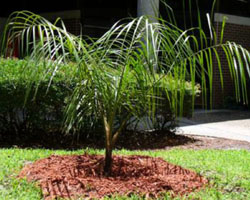x Butyagrus nabonnandii - Mule palm



Family Arecaceae
Description:
Hybrids between different genera of plants are rare (except in the orchid family.) This palm is a cross between Butia capitata (seed source) and Syagrus romanzoffiana (pollen source.) Hybridizing palms by hand is a tedious task because the small flowers are borne on huge spikes. Fortunately for us, Frank and Elaine Lewis of Moultrie Palms in St. Augustine, Florida are dedicated to this task.
The mule palm received this name because, like a mule, it is a sterile hybrid. Like many first generation hybrids, mule palms are fairly uniform in appearance. However, both parent species exhibit some variability and the hybrids may reflect this. They demonstrate hybrid vigor, especially when young. Typically, it will grow to over fifteen feet in height with a stout trunk. Leaves are long and dark green. The leafy crown tends to be fuller than Butia. Mule palms are cold hardy into the teens F. Hybrids with other species of Butia and Syagrus exist but, so far, none rival this particular cross for its combination of beauty and cold hardiness.
Location:
Plants can be seen on the south side of building 1.
Size:
A small tree to fifteen feet tall or more.
Care Instructions:
Light: full sun
Water: drought tolerant once established, responds well to irrigation
Soil: a well-drained soil, no other special requirements
